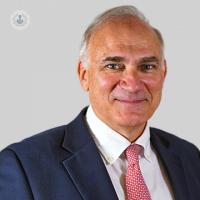Ovarian cysts: types and treatment
Escrito por:What is an ovarian cyst?
An ovarian cyst is a fluid-filled sac within the ovary. There are many different types of ovarian cysts, most of which are benign and go away spontaneously without treatment, however, some types do require surgical intervention to remove them. Mr Angus McIndoe, an award-winning obstetrician and gynaecologist, gives a detailed description of ovarian cysts.
What are the different types of ovarian cysts?
Ovarian cysts are classed as either functional cysts or as abnormal cysts. Functional cysts form as part of the normal menstrual cycle and will usually resolve themselves in a number of weeks without the need for treatment. Abnormal cysts include a range of different types, listed here.
Endometriomas:
An endometrioma cyst is one which forms in women suffering from endometriosis. They form within the ovaries and are made up of endometrial tissue (the membrane that forms the inner layer of the uterine wall). When old blood within these cysts breaks down, it forms a thick chocolate-coloured fluid which can grow in size if untreated.
Dermoid cysts:
Ovarian dermoid cysts are present from birth and are completely benign. They are made up fatty fluid and can contain hair and teeth-like structures, which show up on x-ray scans. They occur at any age but are most commonly detected in women of child-bearing years. Larger dermoid cysts can cause problems, such as pain and twisting of the ovary, potentially blocking the blood supply. These cysts sometimes occur in both ovaries at the same time.
Cystadenomas:
The most common of ovarian cysts, these form in the surface layer of the ovary, called the epithelium. They can occur at any age and are usually benign. They can either be ‘serous type’, which contain a thin fluid, or a ‘mucinous type’ which contain a thicker, gelatinous fluid. These can grow as big as a fully pregnant uterus if left untreated.
Symptoms of ovarian cysts:
The majority of ovarian cysts do not cause symptoms and are usually found when something else is being investigated. However, the following symptoms can sometimes be experienced:
- Lower abdominal pain which is either intermittent, or more frequently, constant
- Irregular menstrual cycle, with bleeding between periods
- Pain during sex
- Abdominal swelling, or a noticeable mass in the abdomen
Treatment of ovarian cysts:
The treatment of ovarian cysts depends on what type of cysts are present. Despite significant advances in imaging and assessment, it can still be challenging to be certain about identifying the nature of an ovarian cyst. Therefore, treatment is based on the probability of various cysts being present. Unfortunately, in some cases, cysts can be cancerous, and this possibility cannot be excluded.
As functional cysts will usually resolve on their own over several weeks or months, they do not require treatment. However, if they persist for several months or causes symptoms, then they can be removed surgically.
If a cyst has increased blood flow, is more than 5cm in size or is potentially cancerous, then surgical removal will be advised too.
Does ovarian cyst removal affect fertility?
In most cases, removing cysts from both ovaries does not affect ovary function, and hence fertility or menstruation. In some cases, surgery can cause adhesions which is when organs stick together, which can cause problems in the transfer of eggs released from the ovaries and down the fallopian tubes. However, with careful surgery, adhesions that affect fertility are very uncommon, unless other abnormalities such as infection or endometriosis are present.
If you would like to learn more, make an appointment with a specialist.



